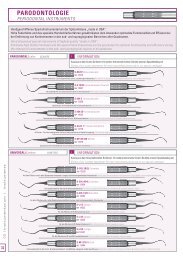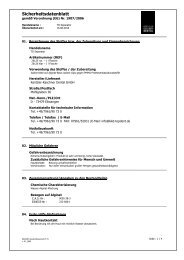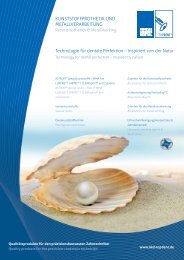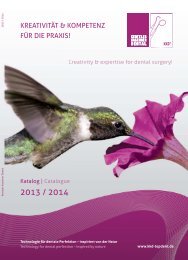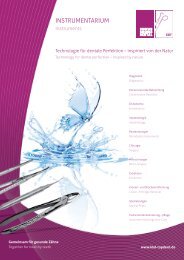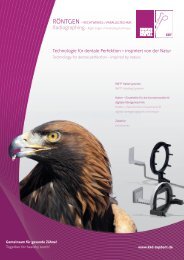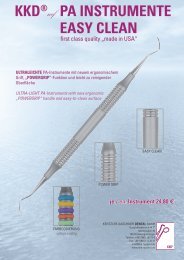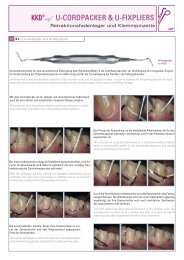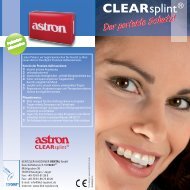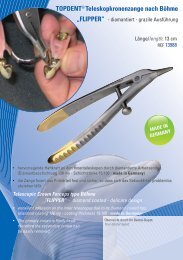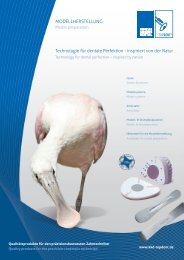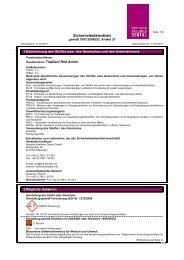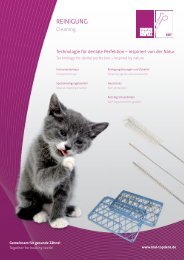OraSoft Unterfütterungsmaterial - KENTZLER-KASCHNER DENTAL ...
OraSoft Unterfütterungsmaterial - KENTZLER-KASCHNER DENTAL ...
OraSoft Unterfütterungsmaterial - KENTZLER-KASCHNER DENTAL ...
You also want an ePaper? Increase the reach of your titles
YUMPU automatically turns print PDFs into web optimized ePapers that Google loves.
ORASOFT<br />
Selbsthärtender Kunststoff speziell zur<br />
direkten, weichbleibenden Unterfütterung<br />
01<br />
ARBEITSANLEITUNG<br />
1. Prothese vorbereiten. Mittels einer Hartmetallfräse oder Sandpapier die zu unterfütternden<br />
Stellen aufrauhen. Eventuell muss Prothesenmaterial abgetragen<br />
werden, um Platz für die Unterfütterung zu schaffen. Die zu unterfütternden Stellen<br />
können mit Methylmethacrylat (Flüssigkeit eines handelsüblichen Autopolymerisates)<br />
benetzt werden; dies bewirkt einen noch besseren Verbund zwischen<br />
Prothese und Unterfütterung.<br />
2. Alle Flächen, die nicht unterfüttert werden, mit einem Isoliermittel (z. B. Vaseline)<br />
abdecken. Darauf achten, daß das Isoliermaterial nicht am peripheren<br />
Rand aufgetragen wird. Es empfiehlt sich, einen Abstand von 3-4 mm zu lassen.<br />
Ebenfalls sollte <strong>OraSoft</strong> nicht mit Kunststoffzähnen in Verbindung kommen.<br />
3. <strong>OraSoft</strong> anmischen. Mischungsverhältnis: 2 Teile Pulver zu 1 Teil Flüssigkeit.<br />
Flüssigkeit in den Mischbecher vorlegen, Pulver dazugeben und gut durchmischen.<br />
Mischzeit ca. 30 Sekunden. Teig zu einer hochviskosen Konsistenz (ca.<br />
3 Minuten) anquellen lassen.<br />
4. Bei allergiegefährdeten oder sehr empfindlichen Patienten empfiehlt sich, das Zahnfleisch<br />
hauchdünn mit Vaseline einzureiben, um einen direkten Kontakt zwischen der<br />
noch nicht gebundenen Unterfütterung und der Schleimhaut zu vermeiden.<br />
5. Mischung auf die zu unterfütternden Stellen auftragen und gleichmäßig verteilen.<br />
6. Die mit <strong>OraSoft</strong> versehene Prothese wie bei einer Abdrucknahme in den Mund<br />
des Patienten einsetzen. Den Patienten bitten leicht zuzubeissen. Nach ca. 3 Minuten<br />
die Bewegungen der mimischen Muskulatur unterstützen.<br />
7. Nach Verfestigung und Erreichung der gummielastischen Phase (nach ca.<br />
4 Minuten), Prothese zu Kontrollzwecken aus dem Mund nehmen und gegebenenfalls<br />
überschüssiges Material entfernen. Prothese sofort wieder in den Mund<br />
einsetzen und weitere 3-4 Minuten belassen. Eventuell nochmals die Bewegungen<br />
der mimischen Muskulatur unterstützen.<br />
8. Zur vollständigen Aushärtung die unterfütterte Prothese 5-10 Minuten in 50°-<br />
60°C heißes Wasser legen. Die gesamte Polymerisationszeit liegt bei maximal 12<br />
Minuten. Zur Erzielung optimalster (praktisch restmonomerfreier) Resultate und<br />
zur Beschleunigung empfiehlt sich die Polymerisation im Drucktopf bei ca. 50° C<br />
warmem Wasser und 2 bar. Wir empfehlen den Polypot, das praktische<br />
und sichere Polymerisationsgerät (druckluftunabhängig, keine elektrischen Teile).<br />
9. Wie üblich ausarbeiten und polieren.<br />
Zur besseren Bearbeitung der weichen Unterfütterung Prothese kurzfristig kalt<br />
lagern oder in eisgekühltes Wasser legen. Die Unterfütterung wird nun hart und<br />
kann, ohne zu schmieren, bearbeitet werden. Bei Mundtemperatur wird die Unterfütterung<br />
wieder weich.<br />
Hinweise zur Reinigung der unterfütterten Prothese: Bei richtiger Behandlung<br />
bleibt die <strong>OraSoft</strong> Unterfütterung etwa 3 Monate weich und elastisch. Eine<br />
regelmäßige Reinigung unter fließend kaltem Wasser ist zu empfehlen. Nur mit<br />
sehr weichen Bürsten reinigen. Keine scharfen Reinigungsmittel verwenden.<br />
02<br />
INFORMATION<br />
<strong>OraSoft</strong> ist ein selbsthärtender Kunststoff speziell zur direkten, weichbleibenden<br />
Unterfütterung von Kunststoff-Prothesen.<br />
<strong>OraSoft</strong> wird direkt auf die Prothese appliziert. Komplizierte Laborprozeduren<br />
entfallen. Eine Unterfütterung mit <strong>OraSoft</strong> ist so einfach wie eine<br />
Funktionsabdrucknahme. Der gesamte Zeitaufwand für eine Unterfütterung<br />
liegt für den Zahnarzt in der Regel bei 12 Minuten.<br />
<strong>OraSoft</strong>, frei von Methylmethacrylat, ist aufgebaut auf der Basis von Copolymeren<br />
der Ethylmethacrylate. Dies garantiert eine größtmögliche biologische Verträglichkeit<br />
während und nach der Verarbeitungsphase. Die <strong>OraSoft</strong> Unterfütterung<br />
ist für eine Mindesttragbarkeit von 3 Monaten konzipiert.<br />
<strong>OraSoft</strong> geht mit jedem auf dem Markt vorhandenen Prothesenkunststoff<br />
eine Verbindung ein.<br />
Indikation von <strong>OraSoft</strong><br />
• Bei dünner, unelastischer, empfindlicher und irritierter Schleimhaut.<br />
• Wenn ein harter Gaumen das Tragen der Prothese erschwert<br />
• Nach einer Kieferoperation oder bei anatomischen Veränderungen<br />
• Bei schmaler, enger, kleiner oder unregelmäßiger Auflagefläche<br />
• Wenn der Patient aus physischen oder psychische Gründen keine Prothese<br />
mit harter Auflagefläche verträgt<br />
• Wenn Freiend- oder partielle Prothesen Schmerzen und Unbehagen verursachen<br />
• Zur besseren Randgestaltung<br />
• Bei Immediat-Prothesen<br />
Sicherheitshinweise: Sicherheitsdatenblatt beachten<br />
Gefahrenhinweise: R 36/37/38 – reizt die Augen, Atmungsorgane und die Haut<br />
R43 – Sensibilisierung durch Hautkontakt möglich<br />
Sicherheitsratschläge: S24 – Berührung mit der Haut vermeiden<br />
S36/37 – bei der Arbeit geeignete Schutzhandschuhe und Schutzkleidung tragen<br />
S61 – Freisetzung in die Umwelt vermeiden<br />
Aufbewahrung: kühl – dunkel – nach Gebrauch sofort wieder verschließen<br />
umweltgefährlich<br />
reizend<br />
Lieferform:<br />
Pkg. mit: 80 ml Pulver 50 ml Flüssigkeit,<br />
1 Mischbecher, 1 Mischspatel<br />
REF 23033<br />
xi<br />
Absender / Praxisstempel / Datum / Unterschrift<br />
BestellFormular<br />
Verrechnung über folgendes Dental-Depot:<br />
Menge REF €/St. €-Gesamtpreis<br />
23033 <strong>OraSoft</strong> Packung<br />
23034 <strong>OraSoft</strong> Pulver 80 ml<br />
23035 <strong>OraSoft</strong> Flüssigkeit 50 ml<br />
Antwortkarte. Passt in Fensterumschlag.<br />
<strong>KENTZLER</strong>-<strong>KASCHNER</strong> <strong>DENTAL</strong> GmbH<br />
Geschäftsbereich<br />
Mühlgraben 36<br />
73479 Ellwangen/Jagst<br />
Irrtümer und Druckfehler vorbehalten<br />
Endbetrag €<br />
Die schnelle Verbindung zu uns - FAX: +49 (7961) 5 20 31<br />
Alle Preise sind unverbindliche Preisempfehlungen in Euro zzgl. gesetzl. MWSt.<br />
Σ<br />
<strong>KENTZLER</strong>-<strong>KASCHNER</strong> <strong>DENTAL</strong> GmbH · Geschäftsbereich · Mühlgraben 36, 36a · 73479 Ellwangen/Jagst<br />
Telefon: +49 - 7961 - 90 73-0 · Fax: +49 - 7961 - 5 20 31 · info@kkd-topdent.de · www.kkd-topdent.de
01 KKD ® ORASOFT - DIRECTIONS<br />
1. Prepare denture. Roughen the parts which have to be relined with a<br />
carbide bur or with sandpaper. Eventually denture base material has to be<br />
taken off to get enough space for the relining.<br />
The parts which have to be relined can be wettened with methyl methacrylate<br />
(liquid of any common self curing resin) to obtain an additional<br />
bonding between denture and relining.<br />
2. The parts which do not have to be relined must be coated with a seperator<br />
(e.g. vaseline). Pay attention that the insulation is not applied on the<br />
denture margin. It is recommended to leave a distance of 3-4 mm. Also<br />
acrylic teeth should not come in touch with <strong>OraSoft</strong>.<br />
3. Mixing <strong>OraSoft</strong>. Mixing ratio 2 parts powder to 1 part liquid. Pour<br />
the liquid into a mixing bowl, add the powder and mix thoroughly. Mixing<br />
time approx. 30 seconds. Allow the paste to well up (approx. 3 minutes) to<br />
a high viscous consistency.<br />
4. If the patient is allergic or has an irritation, it is recommended to rub the<br />
gingiva lightly with vaseline to avoid direct contact with the unset reliner.<br />
5. Apply the mixture evenly onto the surfaces of the denture where it has<br />
to be relined.<br />
6. Insert the denture furnished with <strong>OraSoft</strong> into the mouth of the<br />
patient as if taking an impression. Instruct the patient to close lightly into<br />
occlusion. After approx. 3 minutes support the movement of the mimic muscles.<br />
7. After initial setting and when the mixture has reached its elastic phase<br />
(after approx. 3 minutes), remove the denture from the mouth for control<br />
and if necessary trim off excess material. Reseat denture immediately and<br />
leave it for 3-4 minutes. Eventually support the movement of the mimic<br />
muscles again.<br />
8. For final setting immerse the denture for about 5-10 minutes in hot water<br />
of 50°-60° C. The total polymerization time is maximal 12 minutes.<br />
For optimum results (practically free of residual monomer) and faster<br />
curing, we recommend to use a pressure pot filled with warm water of<br />
approx. 50° C and cure at pressure of 2 bar. We recommend<br />
Polypot, the practical and safe polymerization unit (independent of compressed<br />
air, no electrical parts).<br />
9. Finish and polish as usual.<br />
For better workability of the soft relining, lay the denture at a cool place<br />
or in ice cold water for a short time. The relining becomes hard and can<br />
be finished without clogging. At mouth temperature the relining will get<br />
soft again.<br />
02<br />
INFORMATION<br />
self-curing resin especially for direct and soft relining of acrylic dentures<br />
<strong>OraSoft</strong> is applied directly on the denture. There are no complicated<br />
laboratory procedures. A relining with <strong>OraSoft</strong> is as simple as taking<br />
a functional impression. In general the total time spent on a relining is less<br />
than 12 minutes for the dentist.<br />
<strong>OraSoft</strong>, free of methyl methacrylate, is based on the copolymers of<br />
ethyl methacrylate. This guarantees the best possible biological compatibility<br />
during and after the treatment. <strong>OraSoft</strong> reliner is intended for a<br />
wearing time of at least 3 months.<br />
<strong>OraSoft</strong> combines with every common denture resin<br />
Indication of <strong>OraSoft</strong><br />
• if the patient has a thin, non-elastic, delicate and irritated mucosa<br />
• if a hard palate makes wearing a denture complicated<br />
• after jaw surgeries or anatomic alterations<br />
• if the basal area is narrow, small or irregular<br />
• if the patient cannot wear a denture with a hard basal area because<br />
of physical or psychical reasons<br />
• if free-end saddle or partial dentures cause pain or discomfort<br />
• for better border molding<br />
• with immediate dentures<br />
Directions for cleaning<br />
If treated duly, the <strong>OraSoft</strong> relining will stay soft and elastic for at least<br />
3 months. Periodical cleaning under running cold water is recommended.<br />
Only very soft brushes should be used. Do not use any aggressive cleanser.<br />
Security instructions<br />
<strong>OraSoft</strong> liquid is irritable. It has to be stored at a cool and shadowy<br />
place. Immediately close bottle after every use.<br />
Presentation: 80 ml powder, 50 ml liquid, 1 mixing bowl, 1 spatula<br />
REF 23033<br />
01 KKD ® ORASOFT - INSTRUCTIONS<br />
1. Préparer la prothèse. Dégarnir les endroits de la prothèse qui doivent<br />
être rebasés avec une fraise ou du papier verré. II est possible qu‘on doit<br />
éliminer un peu de matériel de prothèse pour faire place au rebasage. Les<br />
endroits qui doivent être rebasés peuvent être arrosés avec métacrylate<br />
de méthyle (liquide connu d‘une autopolymérisante); avec cela on obtient<br />
un meilleur raccord entre la prothèse et le rebasage.<br />
2. Couvrir les endroits qui ne doivent pas être rebasés d‘un isolant (p.e. Vaseline).<br />
Faire attention à ce que I‘isolant ne soit pas appliqué sur le bord<br />
péripherique de la prothèse. II est recommandé de laisser une distance de 3<br />
à 4 mm. <strong>OraSoft</strong> ne doit pas être contacté avec des dents acryliques.<br />
3. Mélanger <strong>OraSoft</strong>. Proportions de mélange: 2 parts poudre à 1 part<br />
liquide. Mésurer le liquide et ajouter la poudre. Mélanger énergiquement<br />
pendant 30 secondes. Faire gonfler la pâte jusqu‘à ce qu‘une consistence<br />
visqueuse soit atteinte (à peu près 3 minutes).<br />
4. Si le patient est allergique aux résines ou s‘il a un tissu sensible, il est<br />
recommandé, pour éviter un contact direct entre la résine et la muqueuse,<br />
de frictionner la gencive qui entrera en contact avec le matériau de rebasage<br />
pas encore polymérisé légèrement avec de la Vaseline.<br />
5. Appliquer uniformément <strong>OraSoft</strong> sur les endroits qui doivent être rebasés.<br />
6. Placer la prothèse munie de <strong>OraSoft</strong> dans la bouche du patient comme<br />
un porte-empreinte. Dire au patient de serrer en occlusion. Après 3 minutes<br />
I‘ajustement du rebasage doit être supporté par des mouvements masticateurs.<br />
7. Lorsqu‘on a atteint la phase gomme-élastique et lorsque la prothèse est<br />
solide (après à peu près 4 minutes), retirer la prothèse de la bouche pour<br />
la contrôler et enlever tout excédent qui pourrait encore être en place.<br />
Replacer immédiatement la prothèse et laisser pendant 3 ou 4 minutes. Si<br />
nécessaire, répéter les mouvements masticateurs.<br />
8. Pour la polymérisation complète, mettre la prothèse pendant 5-10 minutes<br />
dans de I‘eau chaude de 50° à 60° C. Le temps de polymérisation<br />
maximal est de 12 minutes. Pour obtenir de meilleurs resultats (pratiquement<br />
sans monomères residuels) et pour accélérer la polymérisation, il<br />
est recommandé de polymériser I‘empreinte dans un pot de polymérisation<br />
avec de I‘eau chaude de 50° C et avec une pression de 2 bar. Nous<br />
recommandons Polypot, le pot de polymérisation pratique et sûr<br />
(indépendant d‘air comprimé, pas de parties électriques).<br />
9. Finir et polir la prothèse comme d‘usage. Pour une meilleure adaption du rebasage<br />
mou, mettre la prothèse pour quelque temps dans un congélateur ou dans<br />
de I‘eau glacée. Le rebasage mou devient maintenant dur et peut être fini sans<br />
graisser. A la température buccale, le rebasage deviendra à nouveau mou.<br />
02<br />
INFORMATION<br />
résine autopolymérisante particulièrement pour un rebasage direct et<br />
mou de prothèses en résine acrylique.<br />
<strong>OraSoft</strong> est appliqué directement sur la prothèse. II n‘y a plus de procédures<br />
compliquées dans le laboratoire. Un rebasage avec <strong>OraSoft</strong><br />
est aussi simple que la prise d‘une empreinte fonctionnelle. En général le<br />
dentiste ne consacre que 12 minutes pour un rebasage.<br />
<strong>OraSoft</strong>, exempt de métacrylates de méthyle, est concu à base de<br />
copolymères des métacrylates d‘éthyle. Cela garantit la compatibilité biologique<br />
la plus grande possible pendant et après la période de traitement.<br />
Un rebasage avec <strong>OraSoft</strong> peut être porté pendant 3 mois au moins.<br />
<strong>OraSoft</strong> peut être utilisé avec chaque résine acrylique pour prothèses<br />
en resine acrylique.<br />
Indications de <strong>OraSoft</strong>:<br />
• si le patient a une muqueuse fine, non-élastique, sensible ou irritée<br />
• si un palais dur complique de porter une prothèse après une opération<br />
du maxillaire ou lors de changements anatomiques<br />
• si la surface d‘appui est étroite, mince, petite ou irrégulière<br />
• si le patient ne peut pas porter de prothèse avec une surface d‘appui<br />
dure pour des raisons physiques ou psychiques<br />
• si des prothèses à prolongement ou des prothèses partielles causent<br />
des douleurs ou de la malaise<br />
• pour une amélioration de la formation des bords péripheriques<br />
• lors de prothèses immédiates<br />
Instructions pour le nettoyage: Lors d‘un traitement conforme aux instructions<br />
le rebasage <strong>OraSoft</strong> reste mou et élastique pendant 3 mois. II est recommandé<br />
de nettoyer regulièrement avec de I‘eau froide courante. Nettoyer<br />
seulement avec des brosses très molles. Ne pas utiliser de detergents forts.<br />
Instructions de sécurité: Le liquide de <strong>OraSoft</strong> est irritant. Stocker à un endroit<br />
frais et ombragé. Fermer la bouteille immédiatement après chaque usage.<br />
Présentation: 80 ml de poudre, 50 ml de liquide, 1 bol de melange,<br />
1 spatule REF 23033



